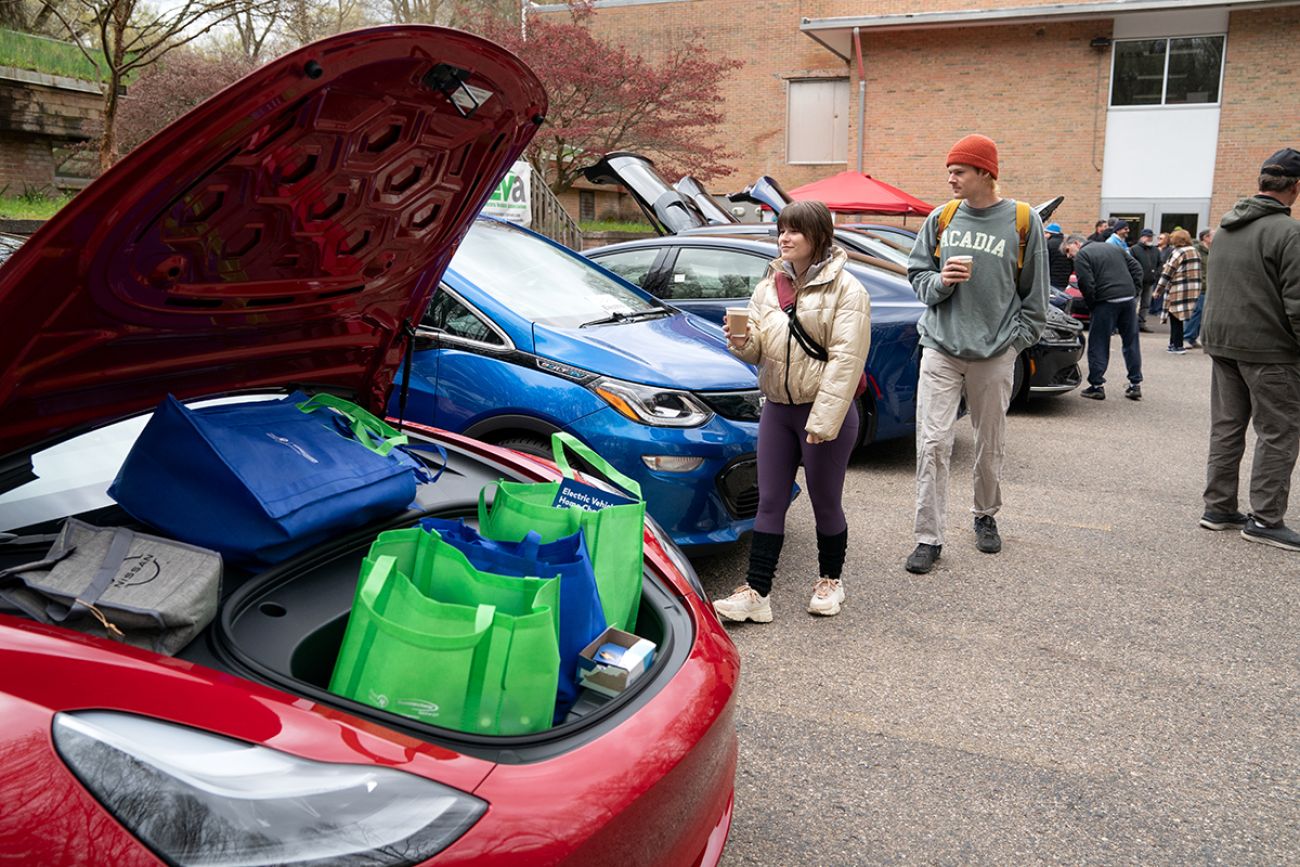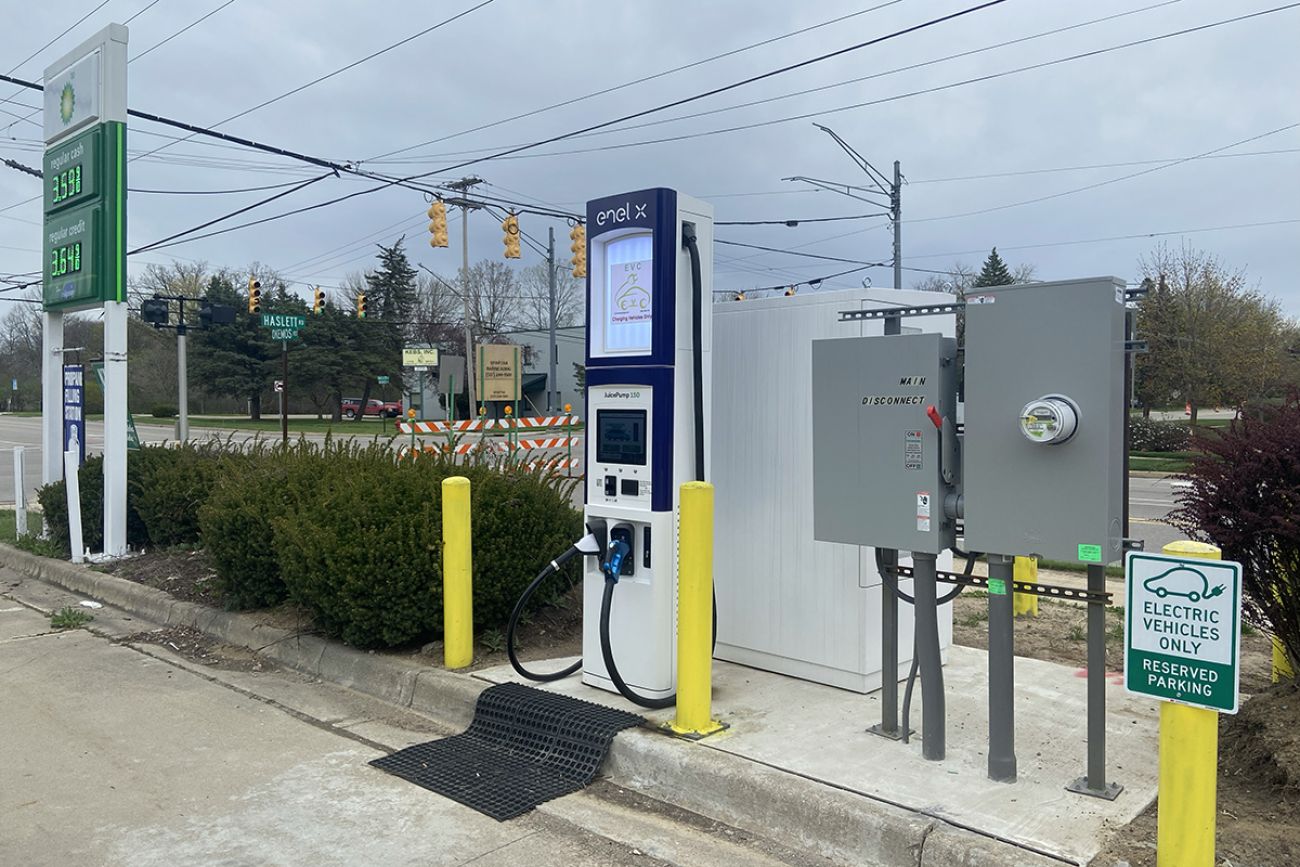EV transition a slow go in Michigan. It needs 100,000 chargers, has 3,300

- State officials believe it will take 100,000 chargers to put 2 million EVs on the road by 2030
- So far, Michigan has just over 3,300
- It needs to build 47 every day for the next six years to catch up
Standing on the porch of Mackinac Island’s Grand Hotel in 2021, Gov. Gretchen Whitmer vowed that soon, Michigan’s western shoreline would boast “the best new road trip for electric vehicle owners in America.”
As she unveiled the plan to build a reliable public EV charging network called the Lake Michigan Circuit, Whitmer invited spectators to imagine the classic Great Lakes vacation: Beaches, wineries, lighthouses and memories “without having to pay a single cent for gas.”
It was the latest in a series of announcements tied to Whitmer’s goal of making Michigan a nationwide leader in the emerging electrical vehicle industry. The backbone of her administration’s plan: putting 2 million electric vehicles on Michigan’s roads by 2030, which state estimates indicate would require 100,000 publicly accessible chargers.
Related:
- Michigan to invest $110M in EV chargers. At $134K a plug, it won’t go far
- Michigan's auto industry awaits an EV revolution in flux
- Researchers say a copper shortage could imperil Michigan’s EV future
- Michigan automakers get breathing room on EVs. Bigger political battle looms
Nearly three years and tens of millions of dollars later, Michigan is well short of its goals, with the Lake Michigan loop needing several hundred more chargers and the state needing 96,000 more.
Private investors so far have been slow to spend on chargers, so the state has gained just 335 in the past year, putting it at a grand total of 1,446 stations with just over 3,300 plugs. To catch up, it must add an average of 47 chargers per day, every day, for the next six years at a cost that’s likely to top $1.5 billion.
One of the most politically charged issues of the day, the transition to electric vehicles not only underpins the 2024 race for president — but it could determine Michigan’s economic future.
Auto manufacturing generated $225 billion annually to the Michigan economy as of 2019 and employs just under 170,000 workers. The World Resources Institute predicts Michigan could gain 56,000 jobs if it “fully embraces” EVs — but would lose 19,000 jobs by 2030 if it does not.
“There is no guarantee that the future of auto making is in the United States,” said Zachary Kolodin, the state’s chief infrastructure officer, who is involved in the EV charging push. “There's lots of competition around the world.”
Spokespeople for Whitmer did not respond to numerous requests for comment.
Michigan is middle-of-the-pack among states in EV infrastructure, and a lack of public chargers has depressed sales of electric cars. At issue, as always: Money.
Michigan has spent about $30 million through three main initiatives, with another $91 million in federal and state funds reserved for the infrastructure.
But with fast chargers costing upward of $150,000 per plug, the money is not coming fast enough.
Legislators have balked at Whitmer’s efforts to expand funding, and private investors are reluctant to shoulder charging costs on their own until EV sales increase.
Michigan has about 43,000 registered EVs today, well under the 60,000 officials once projected by this time. Overall, 3.2% of the state’s car-buyers are choosing an EV, compared to 8% nationally.
The lack of chargers fuels “range anxiety” that makes road trips a gamble for EV drivers like Carrie La Seur of Benzie County.
On a recent trip from Traverse City to Lansing, La Seur found herself repeatedly rerouted and delayed on the 184-mile drive, searching for a place to charge her Volvo C40.
“All it takes is one of the widely spaced chargers to be broken, or somebody else is already there and is staying for a few hours, and I’m really in trouble,” said La Seur.
La Seur said she far prefers her EV over a gas car for daily driving, but “I couldn't really advise having an EV as your only car at this point.”
Clean air, consumer preference
The transition is hugely important to environmental and health goals, as transportation is the leading source of greenhouse gas emissions in the U.S. The family car is the worst offender. Collectively, our cars and trucks emit nearly as much carbon dioxide as the entire country of Japan.
Beyond slowing climate change, a switch to EVs (when paired with a transition to carbon-free electricity sources) would bring immediate health benefits. Hundreds of Michiganders die prematurely each year from air pollution, including soot and toxic gases that spew out of tailpipes.
“You stop putting those pollutants in the air,” said Lisa Del Buono, president of Michigan Clinicians for Climate Action, “and people will have improved health quickly.”
But Michigan’s visions of an EV revolution face a chicken-or-egg problem.

Drivers won’t buy electric cars unless the experience is just as convenient as driving a gas-powered vehicle. And while a median battery range of 270 miles means EV drivers can make the vast majority of their trips without stopping to charge, “range anxiety” remains a concern during road trips and for the 1 million Michigan families in multifamily housing who may lack the ability to charge at home.
“The leading reason why people rule out buying an EV is because they're concerned about public charging,” said Elaine Buckberg, a senior fellow of the Salata Institute for Climate and Sustainability at Harvard University, who was formerly chief economist for General Motors.
In order to meet industry and government EV deadlines, Buckberg said, “we can't keep having constant headlines that public charging sucks.”
To be sure, Michigan is far from alone in its struggles with building EV charging infrastructure. Despite billions in federal funds available, many states have yet to start construction.
In Michigan, officials estimate the state needs at least 9,200 more state-of-the-art fast chargers that can cost well over $150,000 a plug and refuel a battery in about 30 minutes, plus another 87,000 slower “Level 2” chargers that cost a few thousand dollars and take four to eight hours.
Gas stations and other businesses struggle to justify the expense when gas-powered cars still outnumber plug-ins nearly 100 to 1.
“It's hard to make sense of it if you're a retailer,” said Mark Griffin, president of the Michigan Petroleum Association/Michigan Association of Convenience Stores. “Why should I invest all this money today if no one's gonna stop at my station to use it?”
That means Michigan’s charging goals are only achievable if there is “significant, continued commitment from the state and federal government,” said Glenn Stevens, executive director of MichAuto, which is affiliated with the Detroit Regional Chamber and promotes the auto industry.
“I underscore the word significant,” he said.
Political football
Democratic President Joe Biden has gone all-in on EVs. His administration has allocated tens of billions in tax credits for EV purchases and grants and loans for EV manufacturing and authored emissions rules to transform the auto industry to mostly electric or hybrid vehicles by 2032.
His likely opponent, former President Donald Trump, refers to EVs as job killers and has vowed to reverse Biden’s policies and “unleash” the oil and gas industry if he wins in November.
Except for Tesla’s extensive proprietary charging system, “almost not a single charging station in America has been deployed without some type of incentive or grant,” said Loren McDonald, founder of the EV data consultancy EVAdoption.
The money mostly comes from state and federal governments and electrical utilities that sometimes kick in rebates of tens of thousands of dollars per charger. Biden’s National Electric Vehicle Infrastructure Program is the most prominent, allocating $7.5 billion nationally and $110 million for Michigan.
But it may be a while before that makes a difference in La Seur’s life. Companies that received federal money have three years to spend it, and the state expects only a handful of chargers to be installed this year.
Meanwhile, Michigan’s main state-funded public charger initiative, Charge Up Michigan, has installed 106 chargers since it launched in 2019. Its end goal is 150.
The state has another $1.2 million reserved for the Lake Michigan Circuit, according to officials with the Michigan Department of Environment, Great Lakes and Energy, though grants have not yet been announced. Michigan State University researchers concluded it could take a mix of more than 750 fast and slow chargers — at a cost of $20 million — to complete the Lake Michigan circuit.
But the Legislature has been hesitant to free up more money. Last year, Whitmer proposed $65 million to expand the state’s charging infrastructure, but lawmakers allowed $21.3 million to split between chargers and other energy priorities.
This spring, Whitmer has requested $25 million for EV chargers in the state’s 2024-25 budget. Legislators, who have until October to finalize the budget, have indicated they may be open to $15 million.
Some lawmakers contend the state shouldn’t spend any money on a speculative build-out to serve a market that doesn’t yet exist.
“It seems very impractical and counterproductive to me,” said Sen. Ed McBroom, R-Waucedah Township. “(The state is) giving money to people that drive electric cars and then wonders why we're also having less money coming into the fuel tax.”

Free-market advocates, such as the Mackinac Center for Public Policy, contend it’s not the government’s place to subsidize private industry, be it EVs or coal mines.
“If a private company wanted to foot 100% of the cost, make 100% of the profit and take 100% of the risk, I wouldn't have any problem with that,” said Jason Hayes, the think tank’s director of energy and environmental policy.
In all, Michigan has about 1,446 public charging stations and 3,324 ports, compared to 5,000 gas stations in Michigan with about 20,000 pumps.
How far do we have to go?
The 100,000 charger target is only a guess.
The rapid evolution of EV and charging technology makes it impossible to say exactly how many more Michigan needs, when to build them, and how much it will cost, said Mehrnaz Ghamami, a Michigan State University researcher who co-authored a series of reports on Michigan’s charging needs.
Michigan’s EV charger funding
Charge Up Michigan: $6.9 million spent, $2.7 million available
Lake Michigan Circuit: $1.2 million available, awards expected this spring
National Electric Vehicle Infrastructure Program: $22.7 million spent, $87.3 million available
Michigan Department of Environment, Great Lakes and Energy, Michigan Department of Transportation
For example, EV battery ranges are continually expanding, and each extra mile will reduce the number of public chargers needed. Meanwhile, the price of chargers is expected to come down over time, while charging speeds are expected to improve.
Given all the moving parts, installing too many chargers, too early, could be just as big a mistake as installing too few, too late.
“I don't think that they should build a full network and wait for 100% adoption,” Ghamami said. “We can build incrementally.”
State officials say Michigan's public subsidy programs were never meant to do all the work of getting Michigan to 100,000 chargers. Instead, they hope those dollars help meet basic needs, catalyzing a virtuous cycle in which more people feel confident choosing EVs, which in turn makes companies more comfortable investing money in chargers.
The question, said Douglas Jester, managing partner at 5 Lakes Energy consulting firm, is “how do we do enough subsidy to eliminate this barrier and let the market take over, without overdoing it?”
Michigan Environment Watch
Michigan Environment Watch examines how public policy, industry, and other factors interact with the state’s trove of natural resources.
- See full coverage
- Subscribe
- Share tips and questions with Bridge environment reporter Kelly House
Michigan Environment Watch is made possible by generous financial support from:
Our generous Environment Watch underwriters encourage Bridge Michigan readers to also support civic journalism by becoming Bridge members. Please consider joining today.
See what new members are saying about why they donated to Bridge Michigan:
- “In order for this information to be accurate and unbiased it must be underwritten by its readers, not by special interests.” - Larry S.
- “Not many other media sources report on the topics Bridge does.” - Susan B.
- “Your journalism is outstanding and rare these days.” - Mark S.
If you want to ensure the future of nonpartisan, nonprofit Michigan journalism, please become a member today. You, too, will be asked why you donated and maybe we'll feature your quote next time!






